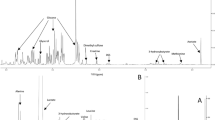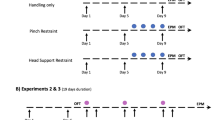Abstract
Blood collection is a common experimental procedure for which there are many different methods, each with its own advantages and disadvantages. Researchers should use methods that minimize pain, suffering, distress and lasting harm to animals while meeting study requirements. The authors evaluated stress, activity and tissue damage in BALB/cO1aHsd mice after collecting blood using one of six methods: retrobulbar bleeding with thin or thick capillaries, tail vein bleeding, saphenous vein bleeding, facial vein bleeding or jugular vein bleeding. The authors compared in-cage activity, corticosterone concentration and performance in open-field tests between treatment groups and collected histologic samples at 1 h, 3 d and 14 d after bleeding. Mice that underwent retrobulbar bleeding with a thick capillary had a smaller change in corticosterone concentration and higher in-cage activity immediately after blood collection, whereas mice that underwent jugular vein bleeding had a greater change in corticosterone concentration and lower in-cage activity and open-field activity. Mice that underwent saphenous vein bleeding had a high incidence of histological change at 1 h, 3 d and 14 d after blood collection, but few indicators of histological change were present in other groups at 14 d after blood collection. These results suggest that, when collecting a small volume of blood, retrobulbar bleeding with a thick capillary and without anesthesia causes the least stress in mice, whereas jugular vein bleeding and facial vein bleeding cause the most stress and saphenous vein bleeding causes the most lasting damage in mice.
This is a preview of subscription content, access via your institution
Access options
Subscribe to this journal
We are sorry, but there is no personal subscription option available for your country.
Buy this article
- Purchase on Springer Link
- Instant access to full article PDF
Prices may be subject to local taxes which are calculated during checkout










Similar content being viewed by others
References
European Union. Directive 2010/63/EU of the European Parliament and of the Council of 22 September 2010 on the protection of animals used for scientific purposes. Official Journal of the European Union L276, 33–79 (2010).
Gesellschaft für Versuchstierkunde/Society of Laboratory Animal Science. Empfehlung zur Blutentnahme bei Versuchstieren, insbesondere kleinen Versuchstieren (Gesellschaft für Versuchstierkunde/Society of Laboratory Animal Science, 2009). http://www.gv-solas.de/fileadmin/user_upload/pdf_publikation/tie_blutentnahme09.pdf.
Diehl, K.H. et al. A good practice guide to the administration of substances and removal of blood, including routes and volumes. J. Appl. Toxicol. 21, 15–23 (2001).
US National Institutes of Health. Guidelines for Survival Bleeding of Mice and Rats (US National Institutes of Health, Bethesda, MD, 2012).
Fitzner Toft, M., Petersen, M.H., Dragsted, N. & Hansen, A.K. The impact of different blood sampling methods on laboratory rats under different types of anaesthesia. Lab. Anim. 40, 261–274 (2006).
Holmberg, H., Kiersgaard, M.K., Mikkelsen, L.F. & Tranholm, M. Impact of blood sampling technique on blood quality and animal welfare in haemophilic mice. Lab. Anim. 45, 114–120 (2011).
Sharma, A. et al. Safety and blood sample volume and quality of a refined retro-orbital bleeding technique in rats using a lateral approach. Lab Anim. (NY) 43, 63–66 (2014).
Van Herck, H. et al. Orbital sinus blood sampling in rats as performed by different animal technicians: the influence of technique and expertise. Lab. Anim. 32, 377–386 (1998).
Van Herck, H. et al. Histological changes in the orbital region of rats after orbital puncture. Lab. Anim. 26, 53–58 (1992).
Heimann, M., Kasermann, H.P., Pfister, R., Roth, D.R. & Burki, K. Blood collection from the sublingual vein in mice and hamsters: a suitable alternative to retrobulbar technique that provides large volumes and minimizes tissue damage. Lab. Anim. 43, 255–260 (2009).
Bazare Jr., J., Leamons, M.L. & Young, J.F. Sampling methods for pharmacokinetic studies in the mouse. J. Pharmacol. Methods 5, 99–120 (1981).
Omaye, S.T., Skala, J.H., Gretz, M.D., Schaus, E.E. & Wade, C.E. Simple method for bleeding the unanaesthetized rat by tail venipuncture. Lab. Anim. 21, 261–264 (1987).
Madetoja, J., Madetoja, M., Mäkinen, J., Riuttala, E. & Jokinen, J. Blood Sampling from the tail vein, in comparison with two other techniques, causes less stress to mice. Scand. J. Lab. Anim. Sci. 36, 215–221 (2009).
Hui, Y.H. et al. Pharmacokinetic comparisons of tail-bleeding with cannula- or retro-orbital bleeding techniques in rats using six marketed drugs. J. Pharmacol. Toxicol. Methods 56, 256–264 (2007).
Aasland, K.E., Skjerve, E. & Smith, A.J. Quality of blood samples from the saphenous vein compared with the tail vein during multiple blood sampling of mice. Lab. Anim. 44, 25–29 (2010).
Müller, B. Blutentnahme aus dem retroorbitalen Venenplexus, den Schwanzvenen und dem jugularen Venenwinkel bei Ratte und Maus: Vergleichende Hämatologisch/Biochemische und Klinische Untersuchungen (Justus-Liebig-Universität, Giessen, Germany, 1999).
Hem, A., Smith, A.J. & Solberg, P. Saphenous vein puncture for blood sampling of the mouse, rat, hamster, gerbil, guinea pig, ferret and mink. Lab. Anim. 32, 364–368 (1998).
Abatan, O.I., Welch, K.B. & Nemzek, J.A. Evaluation of saphenous venipuncture and modified tail-clip blood collection in mice. J. Am. Assoc. Lab. Anim. Sci. 47, 8–15 (2008).
Mazlan, N.H. et al. Comparison of two blood sampling methods in mice in order to increase animal welfare and the reliability of experimental results. Exp. Anim. 60, 226 (2011).
Mitchell, S. Venipuncture techniques in pet rodent species. J. Exotic Pet Med. 20, 284–293 (2011).
Teilmann, A.C., Kalliokoski, O., Sorensen, D.B., Hau, J. & Abelson, K.S. Manual versus automated blood sampling: impact of repeated blood sampling on stress parameters and behavior in male NMRI mice. Lab. Anim. 48, 278–291 (2014).
Golde, W.T., Gollobin, P. & Rodriguez, L.L. A rapid, simple, and humane method for submandibular bleeding of mice using a lancet. Lab. Anim. (NY) 34, 39–43 (2005).
Schlichting, A., Tsai, P.-P., Stelzer, H.D. & Hackbarth, H. Vergleich der retrobulbären Blutentnahme mit der Punktion der V. facialis im Hinblick auf Tierschutzgerechtigkeit (45th Scientific meeting of GV-SOLAS, Dresden, Germany, 2008).
Kassel, R. & Levitan, S. A jugular technique for the repeated bleeding of small animals. Science 118, 563–564 (1953).
Meyer-Eilers, S. Vergleichende Histologische Untersuchung nach Wiederholter Blutentnahme aus dem Jugularen Venenwinkel bei Mäusen und Ratten (Luwig-Maximilians-Universität, Munich, Germany, 2000).
Shirasaki, Y., Ito, Y., Kikuchi, M., Imamura, Y. & Hayashi, T. Validation studies on blood collection from the jugular vein of conscious mice. J. Am. Assoc. Lab. Anim. Sci. 51, 345–351 (2012).
Van Herck, H. et al. Endocrine stress response in rats subjected to singular orbital puncture while under diethyl-ether anaesthesia. Lab. Anim. 25, 325–329 (1991).
Van Herck, H. et al. Orbital bleeding in rats while under diethylether anaesthesia does not influence telemetrically determined heart rate, body temperature, locomotor and eating activity when compared with anaesthesia alone. Lab. Anim. 31, 271–278 (1997).
Van Herck, H. et al. Blood sampling from the retro-orbital plexus, the saphenous vein and the tail vein in rats: comparative effects on selected behavioural and blood variables. Lab. Anim. 35, 131–139 (2001).
Vachon, P. & Moreau, J.P. Serum corticosterone and blood glucose in rats after two jugular vein blood sampling methods: comparison of the stress response. Contemp. Top. Lab. Anim. Sci. 40, 22–24 (2001).
Christensen, S.D., Mikkelsen, L.F., Fels, J.J., Bodvarsdottir, T.B. & Hansen, A.K. Quality of plasma sampled by different methods for multiple blood sampling in mice. Lab. Anim. 43, 65–71 (2009).
Fernández, I., Pena, A., Del Teso, N., Perez, V. & Rodriguez-Cuesta, J. Clinical biochemistry parameters in C57BL/6J mice after blood collection from the submandibular vein and retroorbital plexus. J. Am. Assoc. Lab. Anim. Sci. 49, 202–206 (2010).
Chan, Y.K. et al. Influence of tail versus cardiac sampling on blood glucose and lipid profiles in mice. Lab. Anim. 46, 142–147 (2012).
Flint, M.S. & Tinkle, S.S. C57BL/6 mice are resistant to acute restraint modulation of cutaneous hypersensitivity. Toxicol. Sci. 62, 250–256 (2001).
Nyuyki, K.D., Maloumby, R., Reber, S.O. & Neumann, I.D. Comparison of corticosterone responses to acute stressors: chronic jugular vein versus trunk blood samples in mice. Stress 15, 618–626 (2012).
Ganea, K., Liebl, C., Sterlemann, V., Muller, M.B. & Schmidt, M.V. Pharmacological validation of a novel home cage activity counter in mice. J. Neurosci. Methods 162, 180–186 (2007).
Gould, T.D., Dao, D.T. & Kovacsics, C.E. The open field test. in Mood and Anxiety Related Phenotypes in Mice (ed. Gould, T.D.) 1–20 (Humana, New York, 2009).
Kale, P.P., Addepalli, V. & Ghadawale, S.R. Impact of pre-exposure of tail suspension on behavioural parameters like locomotion, exploration, and anxiety in mice. Indian J. Exp. Biol. 51, 732–738 (2013).
Liu, S.B. et al. Attenuation of reserpine-induced pain/depression dyad by gentiopicroside through downregulation of GluN2B receptors in the amygdala of mice. Neuromolecular Med. 16, 350–359 (2014).
Nicklas, W. et al. Recommendations for the health monitoring of rodent and rabbit colonies in breeding and experimental units. Lab. Anim. 36, 20–42 (2002).
Schlichting, A., Haberstroh, H., Tsai, P.-P., Stelzer, H.D. & Hackbarth, H. Stress Response of Mice under Different Volatile Anaesthesia (11th FELASA Symposium, Helsinki, Finland, 2010).
Tsai, P.P., Stelzer, H.D., Hedrich, H.J. & Hackbarth, H. Are the effects of different enrichment designs on the physiology and behaviour of DBA/2 mice consistent? Lab. Anim. 37, 314–327 (2003).
Corbach, S. Investigation of Carbon Dioxide–Euthanasia of Laboratory Mice Regarding Animal Welfare Aspects (School of Veterinary Medicine Hannover, Hannover, Germany, 2006).
Teilmann, A.C. et al. Physiological and pathological impact of blood sampling by retro-bulbar sinus puncture and facial vein phlebotomy in laboratory mice. PLoS One. Published online 26 November 2014 (10.1371/journal.pone.0113225).
Weiss, J., Maeß, J. & Nebendahl, K. in Haus- und Versuchstierpflege 2nd edn. (Enke, Stuttgart, Germany, 2003).
Acknowledgements
We thank the institutes that sent their well-trained technicians or researchers to Hannover to participate in this study for their support. Parts of these results were presented as a poster at the 12th FELASA SECAL congress held 10–13 June 2013 in Barcelona, Spain.
Author information
Authors and Affiliations
Corresponding author
Ethics declarations
Competing interests
The authors declare no competing financial interests.
Rights and permissions
About this article
Cite this article
Tsai, PP., Schlichtig, A., Ziegler, E. et al. Effects of different blood collection methods on indicators of welfare in mice. Lab Anim 44, 301–310 (2015). https://doi.org/10.1038/laban.738
Received:
Accepted:
Published:
Issue Date:
DOI: https://doi.org/10.1038/laban.738
This article is cited by
-
Protective effects of Bifidobacterium bifidum FL-228.1 on dextran sulfate sodium-induced intestinal damage in mice
European Journal of Nutrition (2023)
-
Comparison of murine retroorbital plexus and facial vein blood collection to mitigate animal ethics issues
Laboratory Animal Research (2021)
-
Stress and behavioral correlates in the head-fixed method: stress measurements, habituation dynamics, locomotion, and motor-skill learning in mice
Scientific Reports (2020)
-
Recent Advances in Experimental Models of Breast Cancer Exosome Secretion, Characterization and Function
Journal of Mammary Gland Biology and Neoplasia (2020)
-
Sex differences in variability across timescales in BALB/c mice
Biology of Sex Differences (2017)



